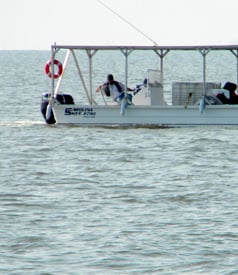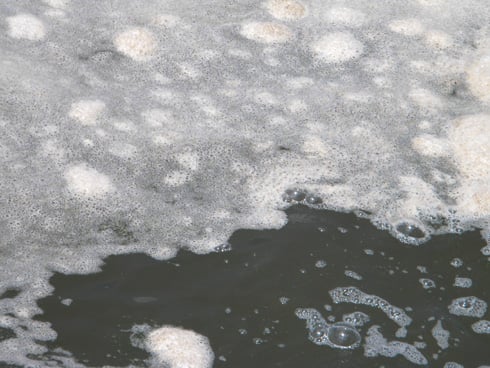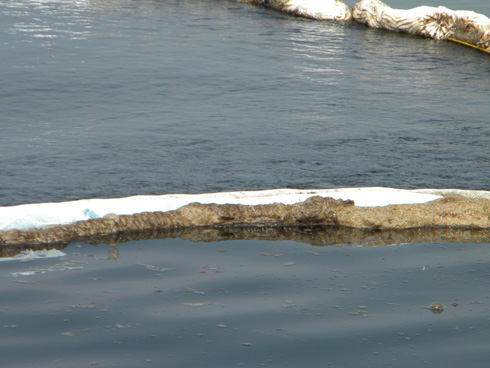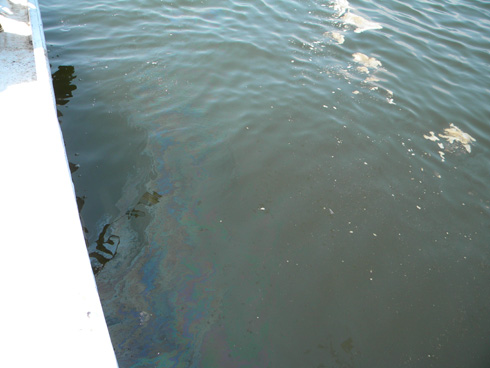Shirley and Don Tillman, residents of Pass Christian, Mississippi , have owned shrimp boats, an oyster boat and many pleasure boats. They spent much time on the Gulf of Mexico before working in BP
, have owned shrimp boats, an oyster boat and many pleasure boats. They spent much time on the Gulf of Mexico before working in BP 's Vessels Of Opportunity (VOO) program looking for and trying to clean up oil.
's Vessels Of Opportunity (VOO) program looking for and trying to clean up oil.

Private contractor in Carolina Skiff with tank of Corexit dispersant, August 10, south of Pass Christian Harbor, 9:30 AM. (Photo: Don Tillman)
Don decided to work in the VOO program in order to assist his brother, who was unable to do so due to health problems. Thus, Don worked on the boat and Shirley decided to join him as a deckhand most of the days.
"We love the Gulf, our life is here and so when this oil disaster happened, we wanted to do what we could to help clean it up," Shirley explained to Truthout.
However, not long after they began working in BP's response effort in June, what they saw disturbed them. "It didn't take long for us to understand that something was very, very wrong about this whole thing," Shirley told Truthout. "So that's when I started keeping a diary of what we experienced and began taking a lot of pictures. We had to speak up about what we know is being done to our Gulf."
Shirley logged what they saw and took hundreds of photos. The Tillmans confirm, both with what they logged in writing as well as in photos, what Truthout has reported before: BP has hired out-of-state contractors to use unregistered boats, usually of the Carolina Skiff variety, to spray toxic Corexit dispersants on oil located by VOO workers.
Shirley provided Truthout with key excerpts from the diary she kept of her experiences out on the water with her husband while they worked in the VOO program before they, like most of the other VOO workers in Mississippi, were laid off because the state of Mississippi, along with the US Coast Guard, has declared there is no more "recoverable oil" in their area.
"The first day I went, I noticed a lot of foam on the water," reads her entry from June 26. "My husband said he had been seeing a lot of it. At that time, we were just looking for 'Oil.' We would go out in groups of normally, five boats. The Coast Guard was over the VOO operation. There was always a Coast Guard on at least one of the boats. They would tell us when to leave the harbor, where to go and how fast to go. They had flags on each of the VOO boats and also a transponder. Sometimes we would have one or more National Guardsmen in our group too, as well as an occasional safety man to monitor the air quality and procedures on the boat. If we found anything, the Coast Guard in our group would call it in to 'Seahorse' and they would determine what action would be taken."
Along with giving a clear description of how the Coast Guard was thus always aware of the findings of the VOO workers, her diary provides, at times, heart-wrenching descriptions of what is happening to the marine life and wildlife of the Gulf of Mexico.
"Before we went to work, I went down by the beach," reads her entry from July 4. "There were dead jellyfish everywhere. Some of them were surrounded by foam. A seagull was by the waters edge, as the foamy stuff continued to wash up. There was also a crane that appeared to be sick. It didn't look like it had any oil on it, but it just stood there, no matter how close I got."
On the morning of August 5, Shirley describes spotting a dead young dolphin floating in the water. "As we waited for the VOO Wildlife boat to come pick it up, we noticed a pod of dolphins close by," she writes. "Even with all the boats around, they did not leave until the dead one was removed from the water. It was very emotional, for all of us."
The next day, August 6, found her logging more death. "Last night on the news, they reported a fish kill. Before we went to work, I went to the beach by the harbor. The seagulls were everywhere. As for the dead fish, the only ones on the beach, were ones that the tide had left when it went back out. The rest of the 'Fish Kill,' was laying underwater, on the bottom. It was mainly flounder and crab. We only spotted two dead flounder floating that day. I can only imagine how many were on the bottom ... I went back to the beach after work. The tide had gone out and the seagulls were eating all the dead fish that had been exposed. You could still see dead fish underwater, still on the bottom. Dead fish don't float anymore?"
The Tillman's primary concern is the rampant use of toxic dispersants by what they described as private contractors working in unregistered boats, that regularly were going out into the Gulf as they and other VOO teams were coming in from their days' work. There was, oftentimes, so much dispersant on top of the water, their boat left a trail.
"The first thing I noticed, was the 'trail' the boat was leaving in the water," her log from July 10 reads. "You could see exactly where we had been, as far back as you could see. Around 11:00, we were in oil sheen and brownish clumps. We were North of Cat and Ship Island when the Coast Guard told us to drop the boom over. When you pick the boom up, you have to wear 'protective gear.'"
Her log from August 1 describes, in detail, an incident of the Coast Guard not allowing them to collect oil and his proceeding to deny what they found was even oil:
"Around 2:00 p.m., we started noticing a lot of oil sheen. We were North of the East end of Cat Island, but South of the Inter Coastal channel. There was, as usual, a Coast Guard on one of the boats in our team. He called in to report it, but we were told not to drop the boom, it was just 'Fish Oil.' In the beginning of the clean-up operation, if something was floating on the water and it looked like oil, it was oil or oil sheen. Later they would sometimes say it was just 'Fish Oil.' Also, if it was heavy foam with a brown or rust color, originally it was 'Oil Mousse.' Later it was called 'Algae.' We were then told to head Northwest. The further we went, the worse the 'Fish Oil' got. Then, the foam was mixed in with the oil. It was at least the size of a football field, around our boat alone. My husband got on the radio and asked if they could put the boom over." The Coast Guard, again, told them no. "We were then headed West, back towards Pass Christian. A pleasure boat flagged one of the boats in our group down and told him that there was oil all over. The Coast Guard said to tell him that they were aware of the situation ... On the way back to the Pass Harbor, I asked my husband, 'Just exactly what are we even doing out here?' He told me that he was beginning to think that it was all just for show. I can only imagine what the people on the pleasure boat had to say when they got back home that day. Probably, that they had seen a lot of oil on the water and the VOO boats were out there just riding around in it and not doing anything to clean it up. That is exactly what happened. We decided then to start documenting as much as we could. I believe it was the very next day, Thad Allen was on TV saying that they were scaling operations back due to the fact that, 'No oil has been seen in the Gulf in almost two weeks.' Now, if we had pulled boom on Sunday and unloaded a bunch of dirty boom in the Pass harbor, it might have been a problem for him later."

Dispersant remnant, June 26, 2010. (Photo: Shirley Tillman)
On August 5, she describes a rare instance of their being allowed to drop boom in order to collect oil. "We had a Coast Guard and two Safety Men on our boat. We went to the West of the Pass Harbor. The water looked black in places. Lots of bubbles, not foam, just bubbles. Around 8:30, we were in oil sheen and mousse and were told to drop the boom. The more we pulled the boom, it appeared the more was coming up. The Pass [Christian] Harbor was closed because the oil was coming in so bad. We pulled boom back and forth the rest of the afternoon."

Oiled boom, August 5, 2010. (Photo: Shirley Tillman)

Oil sheen and dispersant remnant, August 1, 2010. (Photo: Shirley Tillman)
To read rest of article click here
No comments:
Post a Comment